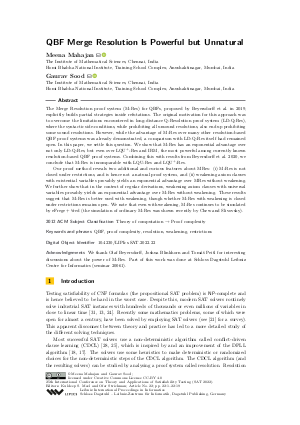LIPIcs.SAT.2022.22.pdf
- Filesize: 0.76 MB
- 19 pages

 Creative Commons Attribution 4.0 International license
Creative Commons Attribution 4.0 International license

The Merge Resolution proof system (M-Res) for QBFs, proposed by Beyersdorff et al. in 2019, explicitly builds partial strategies inside refutations. The original motivation for this approach was to overcome the limitations encountered in long-distance Q-Resolution proof system (LD-Q-Res), where the syntactic side-conditions, while prohibiting all unsound resolutions, also end up prohibiting some sound resolutions. However, while the advantage of M-Res over many other resolution-based QBF proof systems was already demonstrated, a comparison with LD-Q-Res itself had remained open. In this paper, we settle this question. We show that M-Res has an exponential advantage over not only LD-Q-Res, but even over LQU^+-Res and IRM, the most powerful among currently known resolution-based QBF proof systems. Combining this with results from Beyersdorff et al. 2020, we conclude that M-Res is incomparable with LQU-Res and LQU^+-Res. Our proof method reveals two additional and curious features about MRes: (i) M-Res is not closed under restrictions, and is hence not a natural proof system, and (ii) weakening axiom clauses with existential variables provably yields an exponential advantage over MRes without weakening. We further show that in the context of regular derivations, weakening axiom clauses with universal variables provably yields an exponential advantage over M-Res without weakening. These results suggest that M-Res is better used with weakening, though whether M-Res with weakening is closed under restrictions remains open. We note that even with weakening, M-Res continues to be simulated by eFrege+∀red (the simulation of ordinary M-Res was shown recently by Chew and Slivovsky).

Feedback for Dagstuhl Publishing